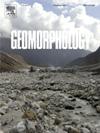A channel shifting GIS toolbox for exploring floodplain dynamics through channel erosion and deposition
IF 3.1
2区 地球科学
Q2 GEOGRAPHY, PHYSICAL
引用次数: 0
Abstract
Assessing spatial patterns and the long-term evolution of river channel planforms is needed for understanding river behaviour and change. GIS tools exist to explore channel planform characters in space and time, but none yet exist to characterise channel shifting and associated floodplain dynamics. The paper presents the applications of a new toolbox that can work as a standalone (e.g., the ArcGIS Standalone channel shifting toolbox - SCS Toolbox) or linked to existing toolboxes such as the fluvial corridor toolbox (FCT). It complemented a wide palette of tools and approaches that are used for understanding and conceptualising river-style and fluvial continuum. Vectorised channel polygons are used to detect the basic morphometric processes between 2 consecutive observation dates as channel erosion, deposition and lateral movement orientation. The toolbox application supports the evaluation of spatial dynamics and lateral erosion by identifying channel migration and reach scale mobility. It also includes floodplain statistics based on combined LiDAR information, where height above the channel and vegetation canopy height are generated. The toolbox was tested on five river systems, some being sinuous (Ain and Topľa Rivers), meandering (Ondava River) or braided-wandering (Belá River). These examples illustrate how spatio-temporal analyses of river channel shifting are used for process-based understanding of channel evolution, in-channel dynamics, lateral movement and floodplain-channel interactions.
求助全文
约1分钟内获得全文
求助全文
来源期刊

Geomorphology
地学-地球科学综合
CiteScore
8.00
自引率
10.30%
发文量
309
审稿时长
3.4 months
期刊介绍:
Our journal''s scope includes geomorphic themes of: tectonics and regional structure; glacial processes and landforms; fluvial sequences, Quaternary environmental change and dating; fluvial processes and landforms; mass movement, slopes and periglacial processes; hillslopes and soil erosion; weathering, karst and soils; aeolian processes and landforms, coastal dunes and arid environments; coastal and marine processes, estuaries and lakes; modelling, theoretical and quantitative geomorphology; DEM, GIS and remote sensing methods and applications; hazards, applied and planetary geomorphology; and volcanics.
 求助内容:
求助内容: 应助结果提醒方式:
应助结果提醒方式:


